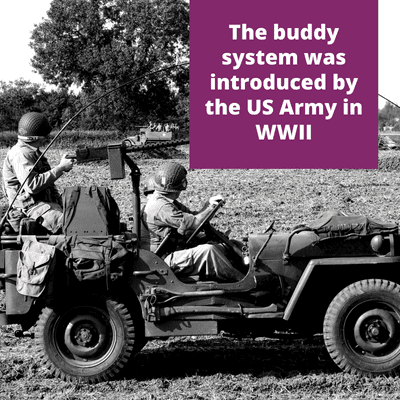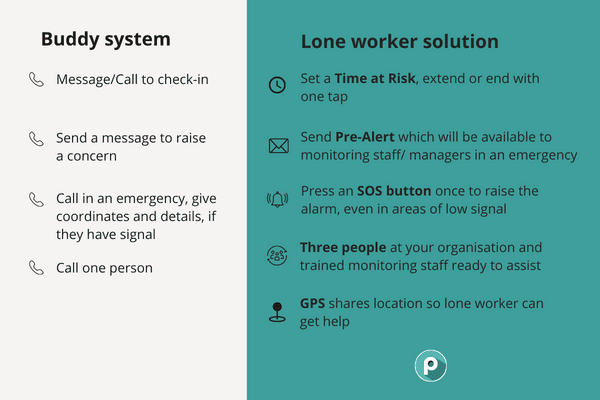Buddy systems have played an important role in help ensure people’s safety at work since World War II. So why was the buddy system introduced, how is it used today, and where can a lone worker solution make improvements?
What is a buddy system?
A buddy system at work is when two team members, normally at the same professional level or working on the same tasks, are paired up with one another. The purpose of this system is two-fold.
Firstly, it can be used as part of an onboarding process, helping new employees find their feet as they share knowledge with the person they’re buddied up with.
The second reason, and the one that we’ll be focussing on, is where each buddy is tasked with looking out for their counterpart from a health, safety and security perspective.

Where is it used?
Buddy systems can be traced back to the U.S. Army in World War II, where the ‘battle buddy system’ was introduced to check decisions, and look out for each other. This led to higher morale, fewer suicides and better teamwork.
It’s easy to see how these benefits translate into the modern day, especially in high-pressure, increased risk and physically demanding environments, such as law enforcement, the military, construction and healthcare.
How does a buddy system work?
The point of a buddy system is to increase safety awareness, offer support, and share knowledge. In buddying up, workers can discuss together new hazards and carry out dynamic risk assessments, and share responsibility for each other’s mental and physical well-being by checking in with each other.
This might look like encouraging a buddy to take a break if they’re getting tired, as this is when mistakes can be made. In case of an emergency, a buddy can be there to offer assistance or call for help, which is why a buddy system is often implemented for lone workers, who might otherwise be facing a dangerous situation without anyone knowing.
What are the advantages of a buddy system?
A buddy system can encourage teamwork and problem-solving, and help avoid mistakes. One person might see a hazard another one doesn’t, or notice that their colleague’s focus is wavering. A new employee who has completed their training may still feel unfamiliar with the role and underestimate the hazards when facing them in reality, and their buddy will be there to guide them.
A buddy might be responsible for everything from checking if their colleague has put on all their PPE equipment properly, to offering to listen to them and share experiences to help them avoid burnout or manage their stress.
While this is a large responsibility, sharing it helps build good working relationships and boosts morale.
Are there any disadvantages to buddying up?
Despite all the benefits of a buddy system, there are some notable drawbacks. There is the issue of creating a false sense of security or even distraction in a high-risk environment. If a worker is operating alongside a teammate instead of on their own, they might feel less inclined to look out for hazards themselves.
If a buddy is accompanying their colleague on a job which only requires one person, this can be an unnecessary expense, especially if there are other safety control measures in place.
And finally, the emphasis on responsibility can be a source of incredible stress to a worker if their buddy suffers an injury and they blame themselves.
Can a lone worker solution replace a buddy system?
Lone worker solutions can offer a safer solution to a buddy system when considering the immediate health and safety of a lone worker.
For example, in a road collision, or a violent altercation, a lone worker app or device can raise an alarm with a precise location to operatives at an Alarm Receiving Centre, who in turn can assess the situation and summon an emergency response if required. If the buddy is involved in the same incident, they might suffer an injury themselves and be unable to get aid.

Lone worker solutions essentially are a low cost, tech-powered buddy system. If the buddy system is being used to check in with a colleague over the phone to confirm their safety, this can be done via a Time at Risk on the PG Smart App and PG Pebble. This can be extended, and if the time elapses, an alarm will automatically be sent to monitoring staff. A lone worker app or device can also detect if someone has had a fall, and raise the alarm.
A lone worker solution can streamline a lot of the buddy system by encouraging regular communication, offering real-time visibility to a situation as it happens, and giving confidence to workers and their managers that they have a reliable means of getting help if needed. With the emergency contact features, each user can benefit from three “buddies” even if they are in low risk role and using our self-monitored option.
If a buddy system remains an essential part of your operation, for training and supervision of new employees, or to encourage greater mental and physical well-being, for example, talk to our team about how a lone worker system can work alongside it, to create greater efficiencies and a more reliable way of protecting lone workers in an emergency.
